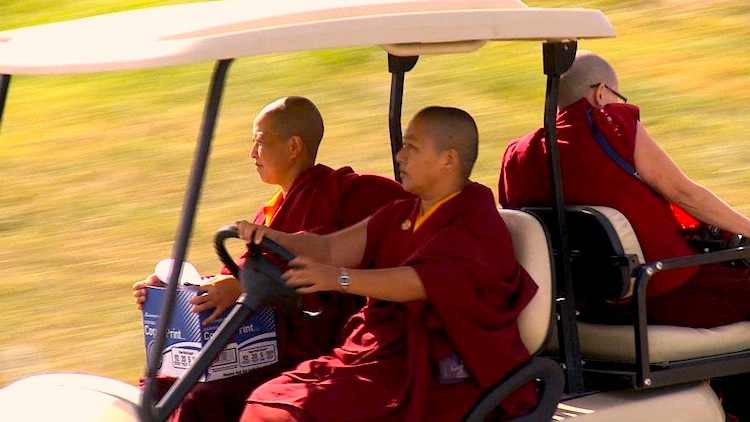By Joe Bendel. Niall Ferguson would say “I told you so.” For centuries, Tibetan Buddhism was largely confined to the Himalayan region. Then China invaded Tibet, precipitating an exodus of refugees. A few decades later, Tibetan Buddhists have earned growing ranks of converts around the world. Arguably, a bit of competition and Westernization has been beneficial. Victress Hitchcock explores the positive implications of their exile in When the Iron Bird Flies: Tibetan Buddhism Arrives in the West, which appropriately screens before and after New Year’s at the Rubin Museum of Art in New York.
It is a rather eerie prophecy in retrospect. In the Eighth Century, Guru Padmasambhava wrote: “When the iron bird flies and horse run on wheels, the Tibetan people will be scattered like ants across the face of the earth.” Communist China realized the prediction with the 1959 invasion. In many ways, it was absolutely devastating to Tibetan culture, particularly during the madness of the Cultural Revolution. Yet Hitchcock suggests it forced one of the world’s most isolated religions into contact with entirely new nations and peoples during the 1960’s, a period when popular Western culture was widely receptive to Eastern thought.
In Iron, Hitchcock challenges our traditional thinking on the Tibetan exile experience, suggesting it has invigorated, modernized, and spread their religious practice. She has a real point. If one took a survey of most American college dorms and neighborhoods, one would be far more likely to find books about Tibetan Buddhism than Mao’s Little Red Book, even in Berkeley. That is a defendable standard of victory, but it has certainly been costly.
Iron revisits subjects of several documentaries that have played at the Rubin over the last two years, including one covering the late E. Gene Smith’s game-changing campaign to preserve and digitize ancient Tibetan texts (fully documented in Dafna Yachin’s Digital Dharma) and another dealing with Chogyam Trunpa, Rinpoche, a learned teacher who adopted a Western business suit and lifestyle to popularize Tibetan Buddhism with the Western counter-culture (profiled in Crazy Wisdom, directed by Johanna Demetrakas, who served as a consulting editor on Iron).
If the learned Rinpoches became evangelists out of necessity, Iron spreads the Tibetan Buddhist “gospel” with the zeal of a convert. Hitchcock clearly hopes to convince Western audiences this once exotic faith speaks directly to the times in which we live. A little of that is all well and good, but she risks alienating the sympathetic by coming on too strong.
Still, Iron offers a fresh perspective on Tibetan Buddhism, capturing its efforts to shed centuries of male chauvinism. It is very definitely the result of Western contact, but also a reflection of the fundamental humanism of the Tibetan Buddhist establishment in exile. Do not hold your breath waiting for similar soul searching from the Islamic world. The wit, erudition, and humility of many exiled Tibetan leaders also help enrich Hitchcock’s portrait. Educational and surprisingly optimistic, When the Iron Bird Flies is definitely worth checking out when visiting the Rubin, home to the world’s leading collection of Himalayan art. It screens again this Wednesday (12/26), Saturday (12/29), and Sunday (12/30), as well as the 2nd and 23rd of January 2013.
LFM GRADE: B
Posted on December 26th, 2012 at 12:02pm.
